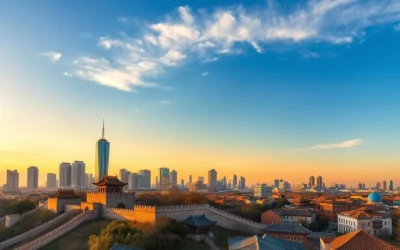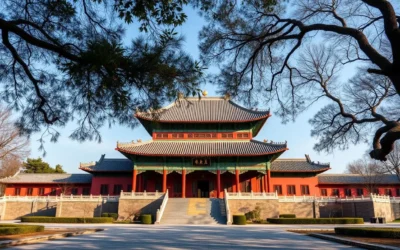✓ Accommodations✓ Flights✓ Rental Cars
Imagine stepping into a world where traditional festivals bring communities together in a burst of color, music, and joy. This region is a cultural treasure, home to 49 ethnic minorities who celebrate over 1,000 festivals annually. Each event is a window into ancient traditions and vibrant customs that have been passed down through generations.
These celebrations are deeply rooted in the Chinese lunar calendar, offering a fascinating glimpse into how time has been marked for centuries. From lively dances to intricate costumes, every detail tells a story of heritage and unity. Whether it’s the rhythmic beats of the Lusheng Festival or the heartfelt rituals of the Sisters’ Meal Festival, there’s something truly magical about these gatherings.
Planning a visit here means immersing yourself in a rich mosaic of cultural experiences. You’ll witness how these events form the cornerstone of local life, connecting people to their roots and to each other. Get ready to explore a region where every festival is a celebration of identity, history, and community spirit.
Overview of Guizhou’s Cultural Festivals
Step into a vibrant world where cultural diversity shines through colorful celebrations. This region is home to 49 ethnic minorities, each adding unique flavors to its cultural tapestry. From intricate costumes to rice-based rituals, every tradition tells a story of identity and unity.
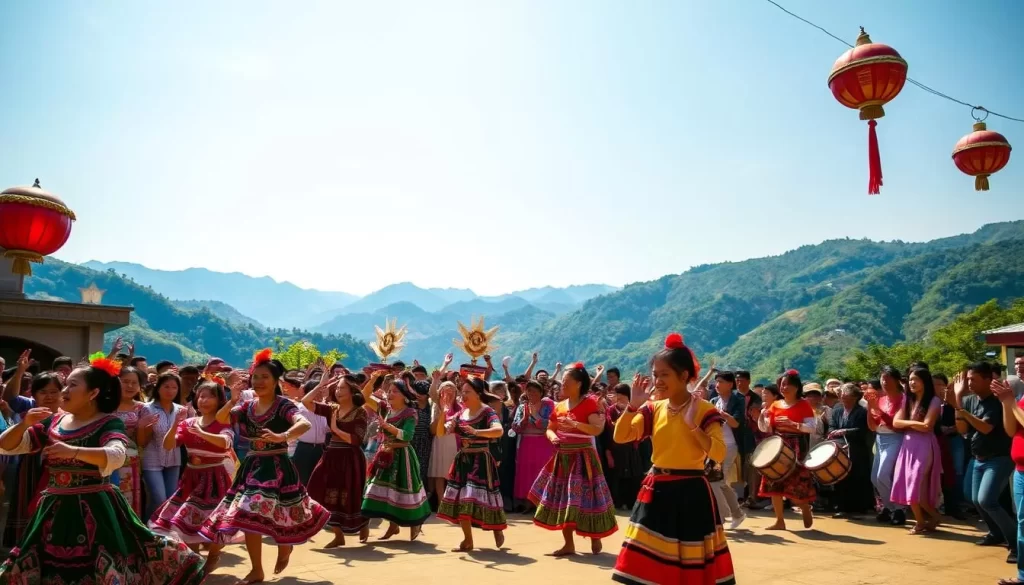
Ethnic Diversity and Traditional Celebrations
Each ethnic group brings its own customs to life through festivals. You’ll see vibrant costumes that symbolize community pride and hear folk songs that echo ancient stories. Dancing is a key part of these events, connecting people to their ancestors and heritage.
Rice plays a central role in many rituals, symbolizing prosperity and unity. These traditions are passed down through families, ensuring that every person plays a part in preserving their culture. It’s a beautiful way to honor the past while celebrating the present.
The Role of Festivals in Local Communities
Festivals are more than just celebrations; they’re the heartbeat of village life. They bring people together, fostering a sense of belonging and mutual support. Whether it’s a group dance or a shared meal, these events strengthen community bonds.
“Festivals are where we connect with our roots and with each other,” says a local villager. This sentiment is echoed in every song, dance, and ritual. It’s a reminder of the power of tradition to unite and inspire.
By participating in these events, you’ll gain a deeper understanding of the region’s rich cultural heritage. It’s an experience that stays with you long after the festivities end.
Guizhou Province, China: Top Festivals to Check Out When Visiting
Immerse yourself in two of the most iconic events that define this region’s cultural spirit. These festivals are not just celebrations but living traditions that connect generations. Each one offers a unique glimpse into the values, artistry, and community bonds that have shaped this vibrant culture.
Sisters Meals Festival – China’s Oldest “Valentine’s Day”
Step into a world of romance and tradition at the Sisters Meals Festival. Held in Kaili from April 12-14, 2025, this event is often called China’s oldest Valentine’s Day. Miao girls prepare four-color rice, a symbol of love and prosperity, to present to their beloved. This gesture is a heartfelt expression of affection and a nod to ancient customs.
During the festival, you’ll see girls adorned in intricate traditional costumes, each piece telling a story of their heritage. Men, in turn, participate in rituals that highlight their roles in courtship. The precise date and time of the festival are deeply rooted in the lunar calendar, adding a layer of historical significance to the celebration.
“It’s a time when love and tradition come together,” says a local participant. The festival also features lively activities like canoeing contests and dragon dances, making it a vibrant experience for all.
Lusheng Festival and Its Musical Heritage
Experience the rhythm of tradition at the Lusheng Festival, celebrated from February 15-17, 2025. This event is a tribute to the lusheng, a traditional wind instrument that has been a cornerstone of Miao culture for centuries. The festival brings together musicians from nearby villages, creating a symphony of folk melodies that resonate through the air.
Dancing is a central part of the celebration, with participants moving in harmony to the music. The event is not just about entertainment but also about preserving a rich musical heritage. The festival miao atmosphere is electric, with colorful costumes and joyful energy filling the space.
“The lusheng is more than an instrument; it’s a voice of our ancestors,” explains a local musician. This festival is a testament to the enduring power of music to unite and inspire.
Experience Festival Traditions in Remote Villages
Journey into the heart of remote mountain villages where tradition thrives untouched by modern influences. Here, celebrations are not just events but a way of life, deeply rooted in history and community spirit.
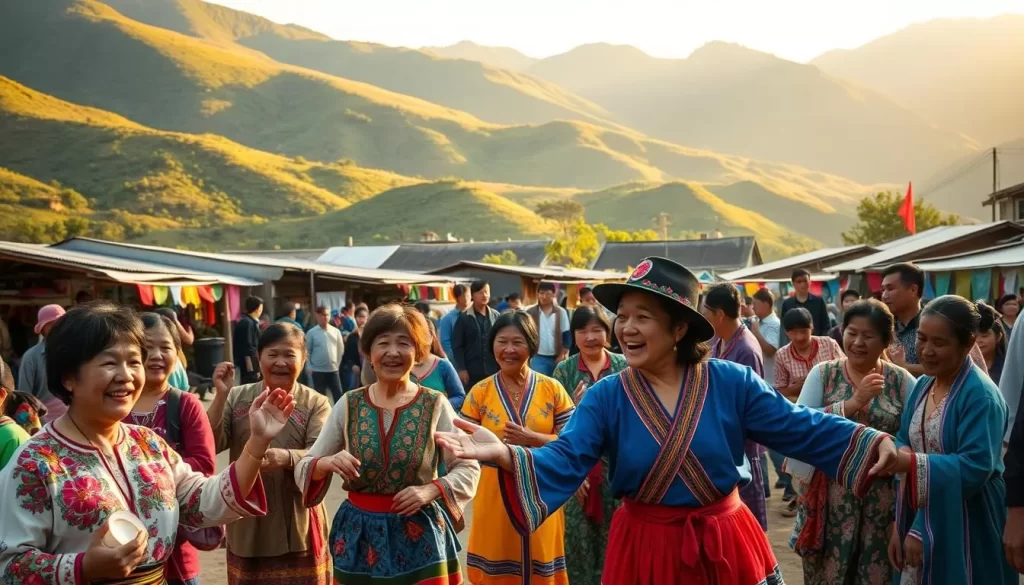
Authentic Village Gatherings and Local Rituals
In these secluded areas, every activity is a reflection of ancestral customs. From collective dances to group rituals, each moment is a step back in time. Neighboring villages often coordinate dates to ensure everyone can participate, fostering a sense of unity.
The natural beauty of the steep mountain backdrop adds to the magic. It’s not just about the vibrant celebrations but also the quiet moments of reflection they inspire. These gatherings bring communities together in close-knit groups, honoring their shared heritage.
“These festivals are our way of staying connected to our roots,” says a local villager. The authenticity of these events is palpable, offering a rare glimpse into a world where tradition remains unbroken.
Discover the Romance of the Sisters Meals Festival
Dive into a celebration where love and tradition intertwine in vibrant hues. The Sisters Meals Festival is a heartfelt event that beautifully blends romance with cultural symbolism. Here, every detail—from the colorful rice to the intricate costumes—tells a story of affection and heritage.
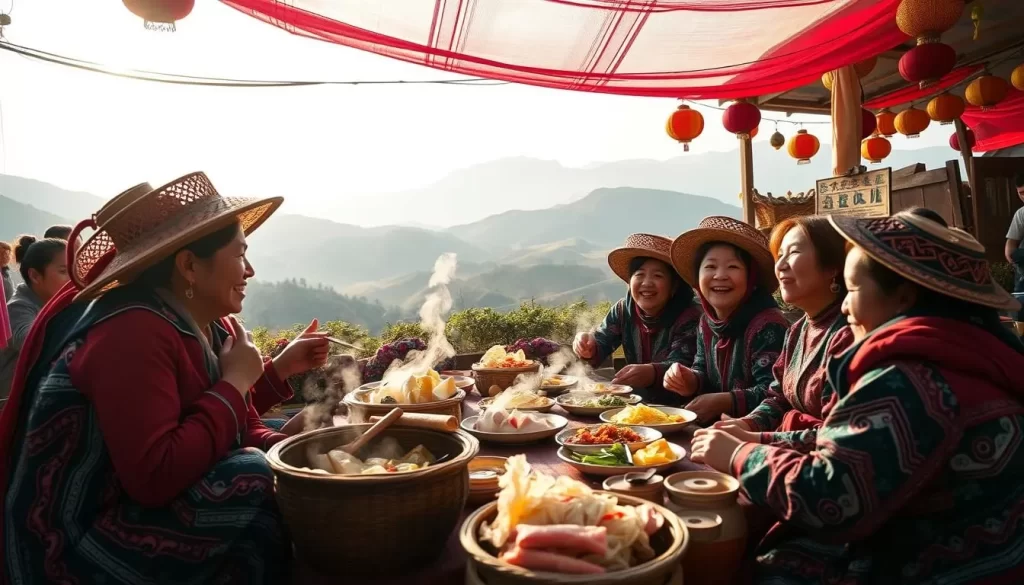
Miao Love Traditions and Cultural Symbolism
At the heart of the festival is the sisters’ rice, a vibrant dish dyed in four colors using natural plant extracts. Each hue represents a season, symbolizing the cycle of life and love. Young women prepare this rice weeks in advance, infusing it with meaning and care. When presented to their beloved, it becomes a powerful gesture of affection and cultural pride.
“The rice is more than food; it’s a message from the heart,” says a local participant. Hidden objects within the rice, like bamboo hooks or garlic stalks, convey subtle emotions—whether it’s a desire for connection or a gentle rejection.
Rice, Costumes, and Ancestral Customs
The festival is also a showcase of stunning costumes, adorned with silver ornaments that reflect the wealth and history of the Miao people. These outfits are not just decorative but deeply symbolic, connecting wearers to their ancestors and traditions.
Dancing and singing are central to the celebration, with performances often accompanied by the lusheng, a traditional wind instrument. These activities are more than entertainment; they’re a way to honor the past and strengthen community bonds.
By participating in the Sisters Meals Festival, you’ll gain a deeper appreciation for how love and tradition are celebrated in this unique cultural event. It’s an experience that stays with you long after the festivities end.
Immerse in the Rhythms of Lusheng and Dragon Canoe Festivals
Feel the pulse of tradition as music and competition come alive in vibrant celebrations. These events are a testament to the region’s rich cultural heritage, blending ancient customs with modern energy. Whether it’s the rhythmic beats of the lusheng or the thrill of dragon boat races, every moment is a celebration of community and pride.
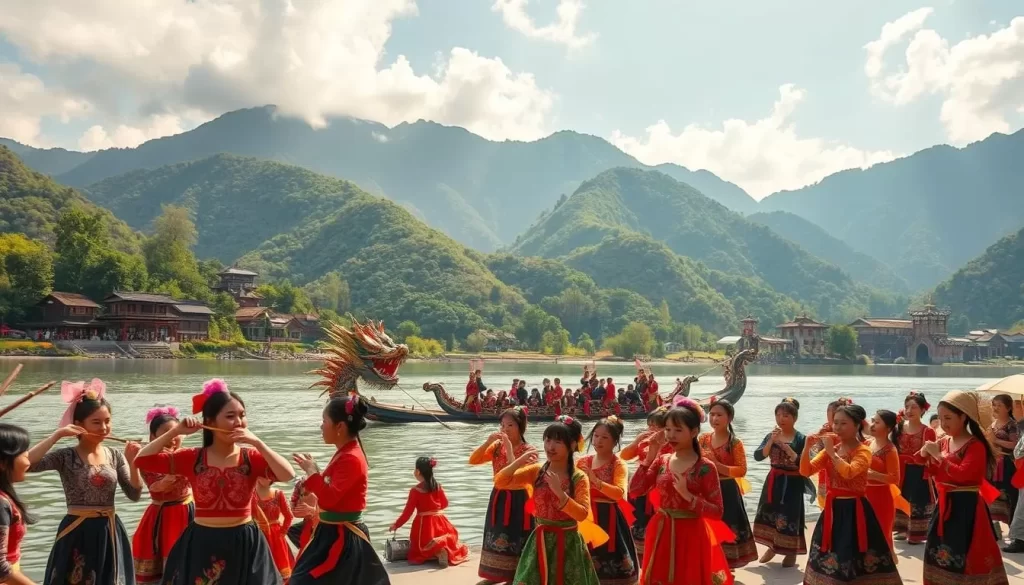
Traditional Music and Dance Performances
The lusheng festival is a feast for the senses. This traditional wind instrument fills the air with melodies that have been passed down for generations. Accompanied by lively dances, the performances are a vibrant expression of cultural identity.
“The lusheng is more than an instrument; it’s a voice of our ancestors,” says a local musician. The festival brings together skilled players from nearby villages, creating a symphony of sound that resonates with everyone present.
Spectacular Boat Races and Community Competitions
The dragon boat races are a highlight of the celebrations. Held during the Dragon Canoe Festival in Shidong, these races are a thrilling display of teamwork and skill. The boats, adorned with intricate dragon designs, glide through the water as spectators cheer.
In addition to boat races, horse racing and other competitions add to the excitement. These events are not just about winning but about bringing the community together in a spirit of camaraderie.
| Event | Date | Location |
|---|---|---|
| Lusheng Festival | February 15-17, 2025 | Various Villages |
| Dragon Canoe Festival | May 31, 2025 | Shidong |
These festivals are a unique opportunity to experience the region’s cultural vibrancy. From the rhythmic beats of the lusheng to the adrenaline of the dragon boat races, every moment is a celebration of heritage and community. Don’t miss the chance to be part of these unforgettable events.
For more insights into cultural experiences, explore this guide to discover other hidden gems in the area.
Embrace Chinese Lunar Calendar Festival Planning
Planning your trip around traditional celebrations? Understanding the Chinese lunar calendar is key. Many festivals, like the Sisters Meals Festival and Miao New Year, are scheduled according to lunar dates, which shift each year. This means their timing varies compared to the Gregorian calendar, adding a layer of complexity to your travel plans.
Understanding The Lunar Dates for Each Festival
The lunar calendar is deeply rooted in cultural traditions. For example, the Sisters Meals Festival takes place on the 15th day of the third lunar month, while Miao New Year aligns with the 10th lunar month. These dates are tied to seasonal and astronomical factors, making them unique each year.
Here’s why this matters for your trip:
- Festivals like the Sisters Meals Festival and Miao New Year are tied to specific lunar dates, which change annually.
- Aligning your travel plans with these dates ensures you don’t miss key events.
- Understanding the Chinese lunar calendar helps you experience these celebrations authentically.
For example, the Sisters Meals Festival in 2025 will be held from April 12-14, based on the lunar calendar. Similarly, Miao New Year falls in late November or early December, depending on the lunar cycle. Checking these dates in advance is crucial for a seamless experience.
“The lunar calendar is more than just dates; it’s a reflection of our cultural heritage,” says a local expert. By syncing your plans with these traditions, you’ll gain a deeper appreciation for the events you attend.
To stay updated, consult reliable sources like this guide on traditional festivals. It provides detailed information on how the lunar calendar influences celebrations across the region.
By embracing the Chinese lunar calendar, you’ll not only plan your trip effectively but also connect with the cultural significance of each festival. It’s a small step that makes a big difference in your travel experience.
A Glimpse into Guizhou’s Ethnic Diversity and Modern Connections
Experience the perfect blend of tradition and modernity in a region where cultural heritage meets cutting-edge progress. Here, the warmth of traditional hospitality coexists with the convenience of modern infrastructure, creating a unique travel experience.
Traditional Hospitality Meets Modern Infrastructure
In this region, every person you meet embodies the spirit of their ethnic minority heritage. From the intricate costumes worn during festivals to the heartfelt greetings in remote villages, the traditions are alive and well.
At the same time, modern advancements like the Guiyang-Guangzhou high-speed railway have made travel faster and more accessible. What once took 7-8 hours now takes just 2-3, allowing you to explore more in less time.
“The blend of old and new is what makes this place special,” says a local woman. “We honor our ancestors while embracing the future.” This balance is evident in every aspect of life, from the bustling cities to the serene villages.
Whether you’re a man or woman, young or old, you’ll find something to appreciate here. The region’s commitment to preserving its ethnic minority traditions while improving infrastructure ensures a memorable visit every year.
For a deeper dive into the cultural tourism boom in this region, explore this guide on its heritage sites and tourism initiatives.
Conclusion
Exploring this region’s vibrant festival scene is like stepping into a living tapestry of culture and tradition. From the rhythmic beats of the lusheng festival to the heartfelt rituals of the sisters meal festival, every event tells a story of heritage and unity. These celebrations are deeply rooted in the Chinese lunar calendar, offering a unique way to experience time-honored customs.
Each village and ethnic group adds its own flavor to the festivities. Whether it’s the colorful costumes or the symbolic rice offerings, every detail reflects a rich cultural mosaic. Activities like dancing, horse racing, and dragon boat competitions bring communities together in a spirit of joy and camaraderie.
Plan your visit around these events to fully immerse yourself in the region’s traditions. With modern travel conveniences, it’s easier than ever to explore these remote mountain areas. Don’t miss the chance to witness the enduring legacy of these festivals and the warmth of the people who keep them alive.
For more insights into cultural experiences, explore this guide to discover other hidden gems in the area.
The above is subject to change.
Check back often to TRAVEL.COM for the latest travel tips and deals.

